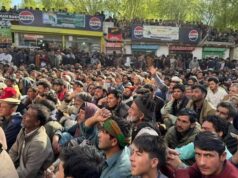Vibrant Village Programme : Is it too little and too less?
By Col Satish Singh Lalotra
‘India lives in its villages’ — Mahatma Gandhi.
The sacred land of India buffeted from both the north and south by impregnable Himalayas and the oceans respectively is still a huge conglomeration of approximately 6.5 lakh villages covering an area of 2.4% of this planet of ours.
This prompted the father of the nation Mahatma Gandhi to opine ‘India lives in its villages’ that still stands true to a large extent even after so many decades. The total land boundary of India extends to about 15,000 kilometers with a coastline of about 7516 kilometers.
The northern boundary of India shared with its neighbours like China, Nepal, Pakistan, Bhutan, Myanmar etc passes through a veritable hue of terrains equally populated by a curious mix of ethnic tribes peculiar to its location having a bearing on its ethnicity.
These tribes of yore like the Bhutias, Lepchas, Gujjars, Bakerwals, Gaddis, have lent their stamp of existence on the terra firma in more ways than one. Hardy by physique, simple by nature and loyal to the core these people have been in fact the frontier sentinels of India unwittingly guarding the country’s vast expanse without even a murmur of protest right from the ‘Great Game days’.
Off late the country has woken up to the delayed reality of putting its best foot forward in giving these border areas its due heft by way of amalgamating them in the main stream of national happenings that have a direct bearing on the country’s future.
Going by an ambitious project known as the ‘VVP-Vibrant Village Programme’, the Government of the day is seized of the sense to put the border villages in their fast forward mode to development that will have a cascading effect not only on the well-being of the region but will give a new direction to hitherto stuck up issues of border area security, employment to the border people, stop rampant migration from these areas to cities/metros and make a marked improvement in the tourist infra of these people at par with the cities of India.
Having given its mind to the problem prevailing in the border areas of the country, the Union Government in the right earnest kick started this ambitious project from one of the easternmost border villages of India ,called as ‘Kibithoo’ just few kilometers from the famous garrison town of ‘Walong’.
Union home minister Amit shah was the man on ground in the month of February to put into action the words and thoughts of the Government at Kibithoo. It is not that the need to develop these border areas was not felt in the last 75 years or so since independence.
The country had an ambitious project suggested under the chairman ship of Major General Himmat Singh Ji in the early 1950s which was constituted by the first PM Nehru with the express intention to develop border areas infra with specific stress laid on roads, bridges, communication lines etc so as to have a faster connectivity with the rest of India.
The committee had at its core certain recommendations given by the first Home Minister Sardar Patel. Unfortunately the iron man of India didn’t live long to see them fructify on ground.
Similarly in the year 1986-87 the famous BADP (Border area development programme) was started for balanced development of border areas of Jammu and Kashmir, Punjab, Gujarat, and Rajasthan and subsequently it was extended to all the land borders.
BADP is also a centrally sponsored scheme with funds provided to the states as a ‘Non-lapsable special central assistance’ for the execution of projects relating to the infra, livelihood, education, health, agriculture and allied sectors.
All these funds were over and above the funds as decided and directed by the ‘Finance Commission of India’ to remove the regional imbalances in the country.
A look at the recently launched VVP conveys the following-
* A total of 2967 villages have been identified for comprehensive development in 46 blocks of 19 districts along the northern border in Arunachal Pradesh, Sikkim, Uttarakhand, HP and Ladakh .
* In the first phase of this programme a population of about 1.42 lakhs will be covered in 662 villages in 46 blocks.
* Sum total of Rs 4800 crores will be spent from 2022 to 2026 and 11 districts ,28 blocks and 1451 villages have been included in this first phase.
* The development work under this ambitious project will be undertaken under three main objectives keeping the ‘Hub and spoke model’ in view -The first objective will envisage promotion of social entrepreneurship ,empowerment of youth and women through skill development and entrepreneurship. The second stage is set for achieving tourism potential through promotion of local ,cultural ,traditional knowledge and heritage and finally culminating into sustainable eco-agribusiness on the concept of OVOP(One village one poduct) through community based organisations and NGOs.
* The three main stages of implementation of this project entails manly stopping of migration from all the villages of the entire northern border, to promote tourism and provide all facilities like cities.
The scheme also envisages raising few ITBP units and their infra worth Rs 120 crores to strengthen security grid as found obtained in the frontiers of the country. A target of 5 years has been set for achieving all these activities to help India come on top of things in its border areas that were hitherto lacking.
The Government plans to rope in panchayats, Gram sabhas, as well as block, district and state entities of administration to help them reach the desired targets in these border areas. Having expressed its intent in so many clear terms of reference, this write up has few following queries which may be gone through to help a discernable reader come to grips of this entire situation —
* Is this VVP Programme started in the country as a measured riposte to the Chinese game plan to enmesh their border villages in the TAR (Tibetan autonomous region) with their avowed national policy of making a common cause with Chinese communist party (CCP) and its stand of co-terminating the local issues with the national issues?
* If the answer is a big ‘Yes’ to the above query then why has the Government of the day waited for so long despite the writing on the wall clear from China’s dubious intent ?
* In the past too various border area development schemes like the BADP , Maj Gen Himmat Singh Ji committee and the financial commission reports to give a heft to the border areas of the country have been doing rounds with near overlapping responsibilities and work schedules. What was the fate of such actions?
* Were all the previous actions undertaken by the Governments since independence an eye wash to help improve the border area infra?
* The border area migration, incursions by the Chinese in our forward areas of Ladakh to include the grazing areas etc have been going around since decades to no end. What was the Modi Government doing since 2014 when major incursions took place in places like Demchok, Hanle etc? Similarly in the central sector near Barahoti recurrent transgressions by the PLA were the norms. Were these villages developed post haste as a result of an afterthought of what happened at Galwan?
* Are the collective funds as a result of plethora of border area development schemes enough ?
* What is the Government mechanism to monitor if the projects so completed under various schemes running concurrently with overlapping schedules meeting the stated objectives so as to prompt the ruling dispensation to start such an ambitious project?
* If the previous border area schemes and the present VVP being co-terminus in their terminal objectives, is there a felt need to continue with a plethora of such moves? If Yes then why and if not then why too.
* With the Uttarakhand state tightening its land laws so as to desist outsiders to purchase land for business purposes, can the so called reverse migration of local hilly people start in the absence of such state laws? This situation is true to almost all NE states too.
* Have the grazing rights of our nomadic people been protected when the same have been under a constant onslaught from our northern neighbour?
There are many such unanswered queries which may hold key to border area development and consequently stymie the Chinese efforts to browbeat India. Be that as it may, since ‘India lives in its villages’ it is back to the drawing board of brainstorming certain ticklish issues that needs an urgent resolution.
(The writer is a retired army officer)





